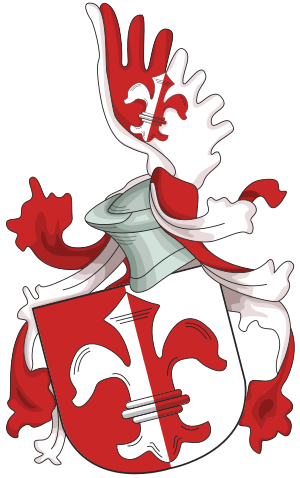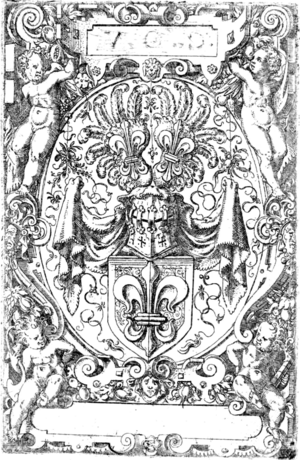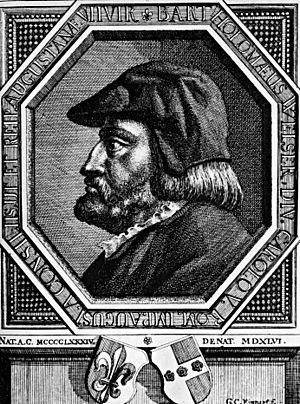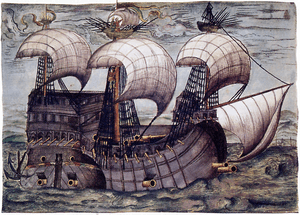Welser family facts for kids
The Welser family was a powerful German family. They were originally a rich and important family from the cities of Augsburg and Nuremberg. In the 1500s, they became very famous for their banking business. They lent huge amounts of money to powerful rulers like the Habsburg family and Emperor Charles V.
Together with another rich family, the Fuggers, the Welsers controlled a big part of Europe's money and trade. They got very wealthy from trading goods and from their involvement in the German colonization of the Americas, which included the forced labor of people. In 1528, Emperor Charles V, who was also King of Spain, gave the Welser family rights to rule the Province of Venezuela. This area was called Klein-Venedig (which means "Little Venice"). However, the Welsers lost their rule in 1546. Philippine Welser (1527–1580), a member of the family, was known for being smart and beautiful. She married Ferdinand II, Archduke of Austria, who was the son of Emperor Ferdinand I.
The Welser family's history goes back to the 1200s. They claimed to be related to the Byzantine general Belisarius. By the early Age of Discovery, the Welsers had set up trading posts in many important cities. These included Antwerp, Lyon, Madrid, Nuremberg, Seville, Lisbon, Venice, Rome, and Santo Domingo. The Welsers not only lent money to the Emperor but also to other European kings and queens. After the Protestant Reformation, both the Welser and Fugger families remained part of the Catholic Church.
Contents
Family History
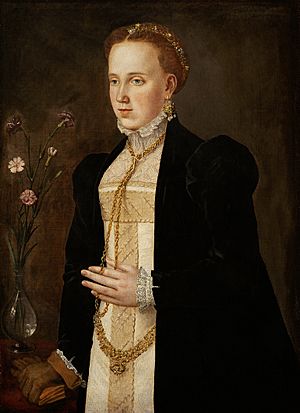
The Welser family's story began in the 1200s. At that time, family members held important jobs in the city of Augsburg. Later, they became well-known as successful merchants. In the 1400s, brothers Bartholomew and Lucas Welser traded a lot with the Levant (the eastern Mediterranean region) and other places. They had offices in major trading cities in southern Germany and Italy. They also had branches in Antwerp, London, and Lisbon. In the 1400s and 1500s, some family members moved to Nuremberg and Austria.
Antony Welser (who died in 1518), a son of Lucas Welser, continued the family business. He was one of the first Germans to use the sea route to the East. This route had been discovered by the explorer Vasco da Gama.
Welser Family in the Americas
Many historians say that the European conquest of the Americas would not have been as successful without help from families like the Welsers. Historian Julia Roth explains that the Welsers' actions in the Americas set an example for other German efforts to colonize new lands.
The Welser family saw a chance to join the conquest of the Americas in the early to mid-1500s. In 1528, King Charles V signed a contract in Madrid. He gave the Welsers special rights in the trade of enslaved Africans and in the Americas. This was a reward for the money they gave him for his election in 1519. By March 1528, they were also given control over the province of Venezuela.
Welser merchants also helped the mining industry in Cuba. They found copper there. German traders, including the Welsers and Fuggers, brought German products to Cuba. These included equipment for mining and building railways. Historians Álvarez Estévez and Guzmàn Pascual say that the Welsers and Fuggers helped Cuba connect with international money for the first time. This opened up Cuban trade to powerful financial groups around the world.
The Venezuela Deal
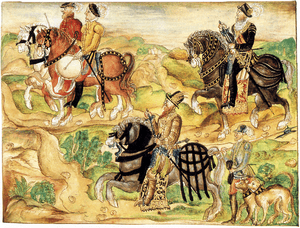
Bartholomeus V. Welser lent a large amount of money to Emperor Charles V. In return, in 1528, he received control of the Province of Venezuela. The Welsers developed this area as Klein-Venedig (little Venice). However, because of their harsh actions, the Welsers lost their rule before the Emperor's time was over. Bartholomeus V.'s son, Bartholomeus VI. Welser, explored Venezuela with Philipp von Hutten. Both were executed in El Tocuyo by the local Spanish Governor Juan de Carvajal in 1546.
From 1528 to 1556, seven expeditions, called entradas, led to the taking of resources and control of local civilizations. These early colonial efforts helped future trade in the Americas. The first governors of Venezuela, Ambrosius Alfinger (1529-1533), Nicolas Federmann, and Georg von Speyer, took local Indigenous people as forced laborers. This happened after they failed to find gold on the Venezuelan coast. The Welsers helped establish cities like Coro, Maracaibo, and Bogotá.
Forced Labor in the Caribbean
The Welsers' involvement in the forced labor of people in the Caribbean began in 1523. They started their own sugar production in Santo Domingo. According to historian Julia Roth, in 1532, the company bought a sugar mill called Santa Bàrbara. They paid for it with money, sugar, and four enslaved people. The fact that enslaved people were listed alongside animals shows how they were treated as property. Over the next 15 years, thousands of enslaved Africans were transported to the Americas.
A Royal Marriage
Bartholomäus V.'s niece, Philippine (1527–80), was the daughter of Franz Welser. She was famous for her intelligence and beauty. She secretly married Ferdinand II, Archduke of Austria, who was the second son of Emperor Ferdinand I. She was given several important titles, including Baroness of Zinnenburg and Margravine of Burgau. Their children could not inherit their father's title as Archdukes of Austria. Their son Margrave Andrew of Burgau became a cardinal in the church, and Charles, Margrave of Burgau became a well-known general.
Family Branches and Titles
Bartholomeus V. Welser was given a noble title by the Emperor in 1532. The main Welser family line in Augsburg ended in 1797. The Nuremberg branch ended in 1878. However, the Ulm branch of the family, who became Imperial Barons in 1713, still exists today. The Welsersche Familienstiftung, a family foundation started on April 1, 1539, still owns many castles in Germany. After the older family lines ended, the Ulm branch became in charge of this foundation.
Legacy
In Augsburg, there are plans for a museum about the history of the Welser and Fugger families (Fugger und Welser Erlebnismuseum).
See also
 In Spanish: Familia Welser para niños
In Spanish: Familia Welser para niños


